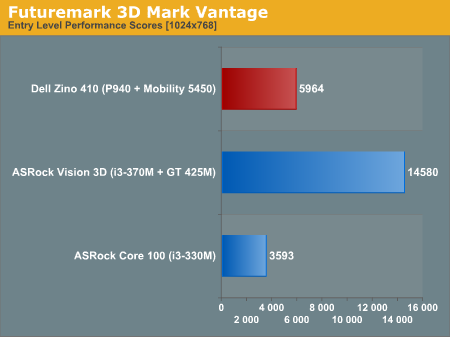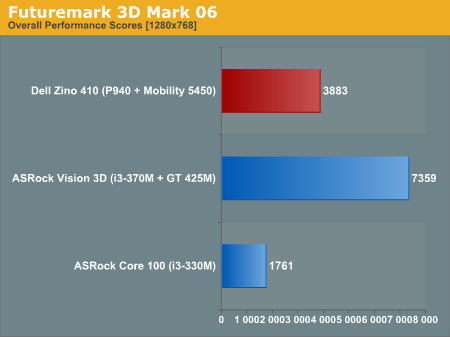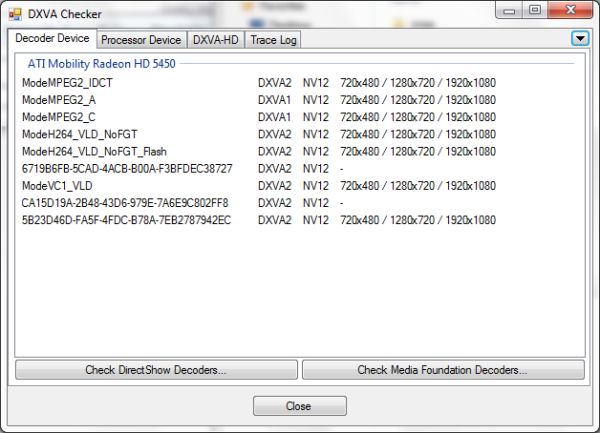Dell Zino HD 410 HTPC Review
by Ganesh T S on February 19, 2011 7:08 AM EST- Posted in
- HTPC
- Dell
- AMD
- Media Streamer
- ATI
The whole purpose of adding the discrete GPU to the Zino 410 was to make sure that the shortcomings of the integrated 4200 series GPU wouldn't be noticed. The Zino 410 provides only one option, namely, the Mobility 5450. How good is it?
We ran the 3D Mark Vantage and 3D Mark 06 benchmarks and the graphs below show how the Mobility 5450 fares when compared to the iGPU of the Core 100 and the GT 425M of the Vision 3D.


The Zino 410 comes in between the Core 100 and the Vision 3D in terms of 3D benchmarks. It is, in fact, closer to the Core 100. This further stresses the fact that the 5450 is only a very marginal improvement over the Intel integrated GPUs with respect to graphics performance.
However, the run-of-the-mill graphics performance is not of much concern to many HTPC users. HD video decoding offload is more important. The Mobility 5450 has the UVD2 decoder engine. UVD2 supports complete hardware decoding of all codecs except for MPEG2, Real Media, On2 codecs.
Here is where the downer comes in. While going through our media streamer test suite, we found that many 1080p60 H264 clips wouldn't play properly. We had protracted communication with both Dell and AMD, and it was one of the main sources of delay with respect to the publishing of this review. We waited quite a bit to see whether driver updates would fix the issue, but release after release went by without any improvement in the situation. After Catalyst 11.1, we gave up.
The short story is that the HD 5400 series (Cedar based) is qualified for content up to 1080p 24fps only. At that format all the video quality features are available with the exception of mosquito noise reduction and deblocking. Anything beyond that format is not qualified for the Mobility 5450. Even though some instances of that format (1080p30 or 1080p60 H264) may play back, it's not guaranteed that it will be smooth.
All in all, the Mobility 5450 falls short in its support for certain encodes when compared with its midrange and high end cousins, as well as the nVidia 4xx GPUs and Intel HD Graphics. Some of the benchmarks show that the graphics performance ought to be better than Intel HD Graphics. In the next section, we will see whether it is true in real world gaming.











69 Comments
View All Comments
strikeback03 - Tuesday, February 22, 2011 - link
The largest PicoPSU I see advertised is a 150W model, which claims 8A/96W of 12V power available. Trying to run a ~60W TDP video card and a 95W TDP processor off that sounds like a bad ideapirspilane - Sunday, February 20, 2011 - link
Did HDMI handshake problem occur in your testing of the ASRock Core100 HT? If so, how can it be fixed?I have a Core100, and have experienced loss of HDMI audio whenever the connection with my Denon AVR is interrupted. Example, I switch the AVR to a different input, when I switch back to the Core100 input, audio is gone, but video is still there.
My PS3 has no problems with this, although there is a several second period before audio is re-established. Anyone else had a problem with a Denon/Core100 setup?
ganeshts - Monday, February 21, 2011 - link
No handshake issue with an Onkyo 606. I don't have a Denon myself.. hopefully some other reader can chime in.By the way, you have a higher probability of finding someone with your setup on AVSForums (There is a dedicated thread for Core100 IIRC) :)
Ganesh_balan - Sunday, February 20, 2011 - link
"A press switch to displace the lid is provided at the top and a Kensington lock slot is at the bottom."Doesn't look like the Kensington lock to me but the hard drive activity indicator. :)
Please re-check! :D
ganeshts - Monday, February 21, 2011 - link
Thanks! Fixed ( was writing another review concurrently and this got mixed up :| )brucek2 - Monday, February 21, 2011 - link
What types of content are typically 1080p60? I had thought most movies were 24fps and most tv shows were 30fps. I'm trying to understand how big a limitation the lack of 1080p60 is likely to be?ganeshts - Monday, February 21, 2011 - link
Camcorders are one of the main sources of 1080p60 content.Some camcorders which record at 1080p60 are: Sanyo HD2000 and Panasonic TM700. There are some other models from the 2 companies which are also 1080p60, but I don't remember offhand.
In addition, user created videos can also be encoded on a PC at 1080p60.
sicofante - Monday, February 21, 2011 - link
Industrial designers must be really expensive to be out of reach for Dell...Why is it that only Apple takes care of the looks of their hardware? It really puzzles me.
This thing is so ugly only true geeks would have it in their living rooms.
myangeldust - Saturday, September 10, 2011 - link
I push mine further back in the TV cabinet. It's all black so it dissappears in the shadows. Like that R2 unit with poorly matched color panels it knows it's ugly so stays in the background and doesn't complaints.cjs150 - Monday, February 21, 2011 - link
I agree with the comment about looks. Apple designs things that look pretty, the Dell looks like cheap plastic.Despite this why are getting close to an ideal HTPC. I know this is subjective but the ideal HTPC should be:
1. Silent (or as close as possible, I do not want to hear it in a quiet bit of a movie)
2. Audio should be capable of being sent through HDMI in all formats my AV receiver can cope with, but with option to use other connectors (some people prefer)
3. Plays all mainstream formats.
4. Has a TV receiver card (here in UK would be nice if it could replace my cable box but I doubt supplier will ever agree)
5. IR receiver
We are very close to ticking all the boxes. Still think it should have an SSD and a 2,5" HD (maybe SSD could replace the wireless card in the mini-PCI slot as my house is fully wired)
Only one issue for me on the thermals of this box, and maybe I missing something but...
The Dell Zino is obviously designed for sitting horizontally on something (why else have the feet on the bottom). Heat rises. To make ideal use of convection therefore the top should be perforated (a mesh would be ideal) to let heat escape and the sides perforated to allow cooler air to replace the hot air leaving the top. (this is not exactly rocket science is it!) So why on earth do designers place the optical drive at the top blocking a large amount of area where the heat would escape. Surely it is more sensible to have the optical drive (and 2.5" HD or SDD) underneath the motherboard.
What am I missing - someone please explain